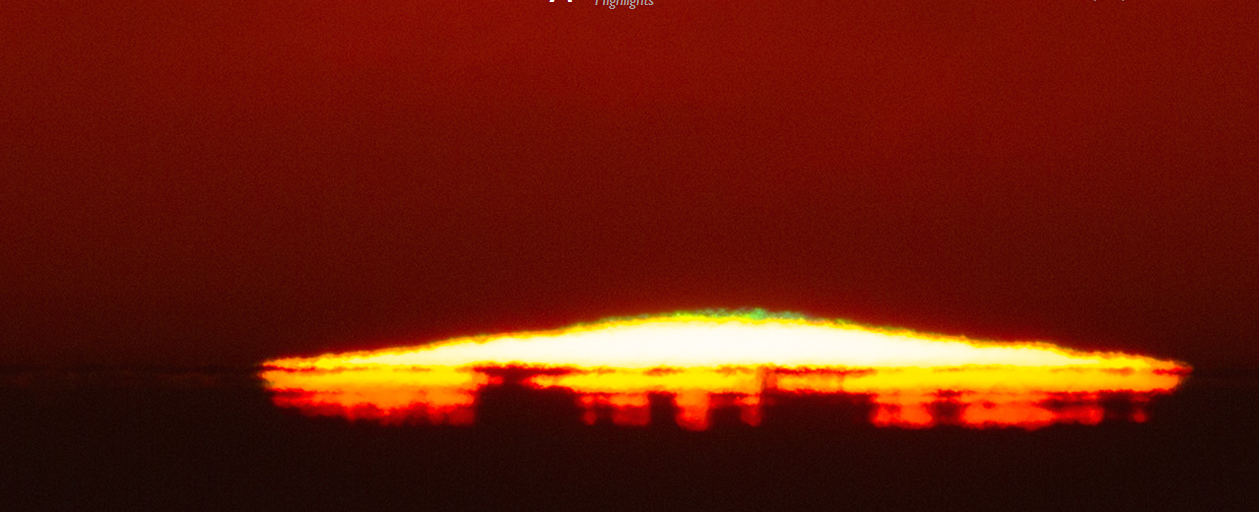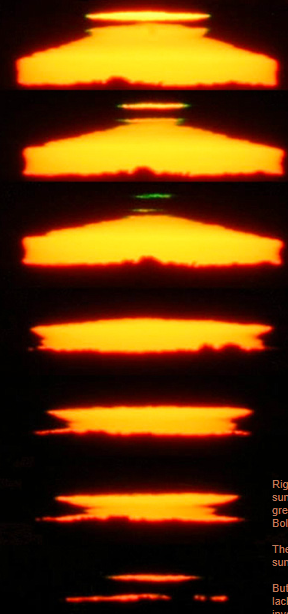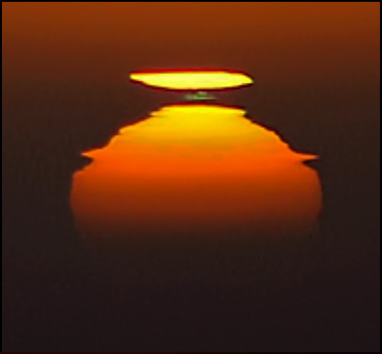High & Low Green Flashes
High & Low Green Flashes: Exploring the Phenomenon
Green flashes during sunsets and sunrises have long captivated the imagination of skywatchers. These optical phenomena occur when light from the Sun is refracted as it passes through layers of varying density in the Earth's atmosphere. While green flashes can be observed from both high and low altitudes, there are distinct differences in their appearance and characteristics. In this article, we will delve into the intriguing world of high and low green flashes and explore the factors that contribute to their formation.
The Mirage Effect: Mock-Mirage Sunsets and Rises
When atmospheric conditions create a temperature inversion, where a layer of warm air overlays cooler air, the resulting density variations can give rise to mirages and green flashes. The interaction between sunlight and these density layers causes the light to bend, leading to the phenomenon we observe as a mirage.
Mock-mirage sunsets and rises are a type of green flash that can be seen when cameras capture the event rather than the classical Jules Verne flashes perceived by the naked eye. The appearance of these mirages depends on whether one is positioned below or within the inversion layer or at heights above it.
Distinct Characteristics of High Green Flashes
When observing green flashes from elevated vantage points, such as mountains or tall structures, unique characteristics become apparent. These high green flashes are often strongly flattened and appear as thin strips rather than full disks. The compression of the miraged sun slices contributes to this flattened appearance.
The height at which one observes a high green flash plays a crucial role in its visual manifestation. Images captured by Jonathan Shock from Table Mountain in Cape Town, South Africa, exemplify this phenomenon. The flattened miraged sun in his photograph showcases the distinct appearance of green flashes seen from elevated positions.
Low Green Flashes: Unveiling Variations
While high green flashes exhibit compression and flattened appearances, low green flashes at or near sea level can present different visual characteristics. In these instances, where the observer is likely within the inversion layer, the mirage experiences less vertical compression. As a result, the miraged sun slices appear less flattened and maintain a closer resemblance to full disks.
Photographs taken by Jim Grant on the Southern California coast and Pierluca Grotto from Monte Novegno in Vicenza, Italy, depict the differences between high and low green flashes. Jim Grant's image shows a mirage with far less vertical compression, suggesting that he was likely positioned within the inversion layer. Conversely, Pierluca Grotto's photograph from an elevated location showcases the flattened appearance of a high green flash.
Ducting and Extreme Squashing
While low-level mock-mirages generally lack significant compression, certain atmospheric conditions can lead to severe squashing of the sunset or sunrise. When the inversion is particularly strong and ducting occurs, multiple stacked lines can be observed, creating a striking visual effect known as a Novaya Zemlya sunrise/sunset.
In some instances, even low-altitude sunset mock-mirages can display minimal vertical distortion in their early stages. An image captured by Jonas Fürste in Jakobstad, Finland, demonstrates this phenomenon, highlighting the variation in appearances within low green flashes.
Conclusion
The captivating world of high and low green flashes continues to intrigue sky enthusiasts worldwide. Whether observing from elevated positions or at sea level, the distinct characteristics of these optical phenomena provide unique insights into atmospheric optics. Understanding the interplay between density layers, temperature inversions, and the observer's position contributes to unraveling the mysteries behind these stunning displays in our skies. So, keep your eyes peeled during sunsets and sunrises for a chance to witness the mesmerizing beauty of high and low green flashes.

High & Low Green Flashes
Jonathan Shock pictured this sunset green flash from high up on Table Mountain, Cape Town, South Africa. It's a mock-mirage type sunset flash that cameras see rather than the classical Jules Verne flashes seen by eye.
Sunset rays refracted by differing density layers of a temperature inversion made the mirage and flash.
The appearance of mock-mirage sunsets/rises depends on whether you are below or in the inversion or at heights above it. Jonathan's miraged sun is typical of those seen from high up (but see the caveat below!). It is strongly flattened . The many miraged sun images each squash into thin strips. Explore the height differences below....
Image ©Jonathan Shock, shown with permission

A mock-mirage sunrise and green flash seen from a height. This time from Monte Novegno (1691m), Vicenza, Italy by Pierluca Grotto.
Each miraged sun slice is well flattened

Left: Sunset series from the ESO La Silla Observatory, high (2400m) in the Atacama Desert, Chile. Image by Jes�s Ma�z Apell�niz.

Right: A mock-mirage sunset and green flash at near sea level. Seen on the Southern California coast by Jim Grant.
The mirage has far less vertical compression. Jim was likely within the inversion.

Right: Another Californian sea-level sunset mirage with intermittent green flashes. Videoed by Michael Bolte.
There is little compression of the sun slices.
But not all low-level mock-mirages lack compression. When the inversion is strong and ducting occurs then we see a severely squashed sunset. In extremis we have the multiple stacked lines of a Novaya Zemlya sunrise/sunset.
Below: There is almost no vertical distortion in the early stages of this low-altitude sunset mock-mirage. Imaged at Jakobstad, Finland by Jonas F�rste

Note: this article has been automatically converted from the old site and may not appear as intended. You can find the original article here.
Reference Atmospheric Optics
If you use any of the definitions, information, or data presented on Atmospheric Optics, please copy the link or reference below to properly credit us as the reference source. Thank you!
-
<a href="https://atoptics.co.uk/blog/high-low-green-flashes-2/">High & Low Green Flashes </a>
-
"High & Low Green Flashes ". Atmospheric Optics. Accessed on April 18, 2024. https://atoptics.co.uk/blog/high-low-green-flashes-2/.
-
"High & Low Green Flashes ". Atmospheric Optics, https://atoptics.co.uk/blog/high-low-green-flashes-2/. Accessed 18 April, 2024
-
High & Low Green Flashes . Atmospheric Optics. Retrieved from https://atoptics.co.uk/blog/high-low-green-flashes-2/.